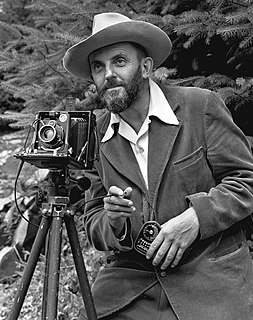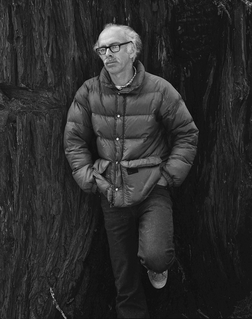Related Research Articles

Ansel Easton Adams was an American landscape photographer and environmentalist known for his black-and-white images of the American West. He helped found Group f/64, an association of photographers advocating "pure" photography which favored sharp focus and the use of the full tonal range of a photograph. He and Fred Archer developed an exacting system of image-making called the Zone System, a method of achieving a desired final print through a deeply technical understanding of how tonal range is recorded and developed in exposure, negative development, and printing. The resulting clarity and depth of such images characterized his photography.
Edwin Herbert Land, ForMemRS, FRPS, Hon.MRI was an American scientist and inventor, best known as the co-founder of the Polaroid Corporation. He invented inexpensive filters for polarizing light, a practical system of in-camera instant photography, and the retinex theory of color vision, among other things. His Polaroid instant camera went on sale in late 1948 and made it possible for a picture to be taken and developed in 60 seconds or less.
Polaroid was an American company best known for its instant film and cameras. The company was founded in 1937 by Edwin H. Land, to exploit the use of its Polaroid polarizing polymer. Land ran the company until 1981. Its peak employment was 21,000 in 1978, and its peak revenue was $3 billion in 1991.

The Land Camera is a model of self-developing film camera manufactured by Polaroid between 1948 and 1983. It is named after their inventor, Edwin Land, who developed a process for self-developing photography between 1943 and 1947. After Edwin Land's retirement from Polaroid, the name 'Land' was dropped from the camera name. The first commercially available model was the Model 95, which produced sepia-colored prints in about 1 minute. It was first sold to the public on November 26, 1948.

The instant camera is a type of camera which uses self-developing film to create a chemically developed print shortly after taking the picture. Polaroid Corporation pioneered consumer-friendly instant cameras and film, and were followed by various other manufacturers.

Instant film is a type of photographic film that was introduced by Polaroid Corporation to produce a visible image within minutes or seconds of the photograph's exposure. The film contains the chemicals needed for developing and fixing the photograph, and the camera exposes and initiates the developing process after a photo has been taken.

Elsa Dorfman was an American portrait photographer. She worked in Cambridge, Massachusetts, and was known for her use of a large-format instant Polaroid camera.

The SX-70 is a folding single lens reflex Land camera which was produced by the Polaroid Corporation from 1972 to 1981.

The Polaroid Model 20 "Swinger" was a popular Land Camera produced by the Polaroid Corporation between July 1965 and 1970. At $19.95 and weighing only 21 ounces, it was the first truly inexpensive instant camera, a fact that helped fuel its enormous popularity and made it one of the top-selling cameras of all time. The Swinger was especially successful in the youth market due to its low price, stylish appearance, catchy Meet the Swinger jingle, as well as getting the camera into drugstores. In fact, it was so successful that it became Polaroid's best selling product at the time, and increased their share in the new camera market.
Polaroid Type 55 film is a black-and-white peel-apart Polaroid film that yields both a positive print and a negative image that can be used to create enlargements.

Born Free and Equal: The Story of Loyal Japanese-Americans is a book by Ansel Adams containing photographs from his 1943–1944 visit to the internment camp then named Manzanar War Relocation Center in Owens Valley, Inyo County, California. The book was published in 1944 by U.S. Camera in New York.
John Sexton is an American fine art photographer who specializes in black and white traditional analog photography.
Marie Cosindas was an American photographer. She was best known for her evocative still lifes and color portraits. She was one of the first photographers to incorporate color photography into her work, which distinguished her from other photographers in the 1960s and 1970s. Most of her photographs were portraits and pictures of objects like dolls, flowers, and masks.

The Polaroid 20×24 camera is a very large instant camera made by Polaroid, with film plates that measure a nominal 20 by 24 inches, giving the camera its name, although at least one camera takes pictures that are 23 by 36 inches.

Moonrise, Hernandez, New Mexico is a black and white photograph taken by Ansel Adams, late in the afternoon on November 1, 1941, from a shoulder of highway US 84 / US 285 in the unincorporated community of Hernandez, New Mexico. The approximate location where the image was taken is 36.057186°N 106.116974°W.

Dody Weston Thompson was a 20th-century American photographer and chronicler of the history and craft of photography. She learned the art in 1947 and developed her own expression of “straight” or realistic photography, the style that emerged in Northern California in the 1930s. Dody worked closely with contemporary icons Edward Weston, Brett Weston and Ansel Adams during the late 1940s and through the 1950s, with additional collaboration with Brett Weston in the 1980s.

Ray McSavaney was an American fine-art photographer based in Los Angeles, California. Throughout a spartan but active life, practicing classical Western black and white fine art photography, he made enduring photographs of buildings, bridges, and street scenes of the vast city, ancient ruins and panoramic vistas of the Southwest, and studio setups with varied floral subjects. He passed away from lymphoma in Los Angeles Veteran's Hospital. Warm tributes to his life and career by some of his close friends and colleagues appear in a ‘celebration of life’ memorial recounted in ‘View Camera’ magazine.
Peter Schlesinger is an American artist, author, and former artist's model, perhaps most well known for being the subject in numerous notable canvases by the British painter David Hockney.

Ellen Carey is an American artist known for conceptual photography exploring non-traditional approaches to light involving process, exposure, and paper that overturn the photograph's conventional status as an iconic "sign" or reproduction of a physical object. Her work has ranged from painted and multiple-exposure, Polaroid 20 x 24, Neo-Geo self-portraits beginning in the late 1970s to cameraless, abstract photograms and minimal Polaroid images from the 1990s onward, which critics often compare to color-field painting. Carey's sixty one-person exhibitions have been presented at museums, such as the Amon Carter Museum of American Art, International Center of Photography (ICP) and Wadsworth Atheneum Museum of Art, alternative spaces such as Hallwalls and Real Art Ways, and many commercial galleries. Her work is in numerous museum collections, including those of the Metropolitan Museum of Art, Whitney Museum of American Art, Los Angeles County Museum of Art, Centre Pompidou, and Smithsonian American Art Museum. In 2019, she was named one of the Royal Photographic Society (London) "Hundred Heroines", recognizing leading women photographers worldwide. Los Angeles Times critic Leah Ollman describes her photography as "inventive, physically involving, process-oriented work" and her recent photograms as "performative sculptures enacted in the gestational space of the darkroom" whose pure hues, shadows and color shifts deliver "optical buzz and conceptual bang." New York Times critic William Zimmer wrote that her work "aspires to be nothing less than a reinvention, or at least a reconsideration, of the roots or the essence of photography." In addition to her art career, Carey has also been a longtime educator at the Hartford Art School and a writer and researcher on the history of photography.
Rebecca A. “Becky” Senf is an American writer, and curator working in the field of photography. She is the Chief Curator at the Center for Creative Photography (CCP). She joined the CCP as Norton Family Assistant Curator in 2007, which was a joint appointment with Phoenix Art Museum, and was promoted to Chief Curator in 2016.
References
- ↑ "'Polaroid Collection' Sale Sets Record At Auction". NPR.org.
- 1 2 3 Warren, Lynne (November 15, 2005). Encyclopedia of Twentieth-Century Photography, 3-Volume Set. Routledge. ISBN 9781135205430 – via Google Books.
- 1 2 3 "Polaroid collection including photographs by Ansel Adams, other top photographers, being auctioned by Sotheby's". cleveland. Associated Press. June 13, 2010.
- ↑ Spaulding, Jonathan (June 17, 1998). Ansel Adams and the American Landscape: A Biography. University of California Press. ISBN 9780520216631 – via Google Books.
- ↑ "Paul Strand and Ansel Adams: Native Land and Natural Scene". Center for Creative Photography, University of Arizona. June 17, 1990 – via Google Books.
- ↑ Nguyen, Sophia (August 3, 2017). "The Portraitist". Harvard Magazine.
- 1 2 "The Cultural Post". 1982.
- ↑ Richard, Frances (May 27, 2016). "The Afterlife of Polaroid" – via www.thenation.com.
- ↑ Fishback, Kurt Edward (2012). Artists Portraits New York 1982. ISBN 9781300279624.
- 1 2 Bonanos, Christopher (August 10, 2012). Instant: The Story of Polaroid. Chronicle Books. ISBN 9781616891589 – via Google Books.
- ↑ "AI-AP | DART » Last Chance: The Polaroid Collection". www.ai-ap.com.
- 1 2 3 agencies, swissinfo ch and. "Polaroid collection saved by Vienna museum". SWI swissinfo.ch.
- ↑ Conrad, Peter (May 29, 2010). "The Polaroid Collection auction" – via www.theguardian.com.
- 1 2 Bonanos, Christopher (26 September 2012). Instant: The Story of Polaroid. ISBN 9781616890858.
- ↑ Vogel, Carol (February 10, 2010). "From That Instant Thrill, Enduring Art, Now for Sale" – via NYTimes.com.
- 1 2 Miller, Leigh Anne; Miller, Leigh Anne (March 30, 2011). "Impossible's Improbable Polaroid Mission".
- ↑ "Galerie WestLicht: Betrieb bis März gesichert". wien.orf.at. November 17, 2017.